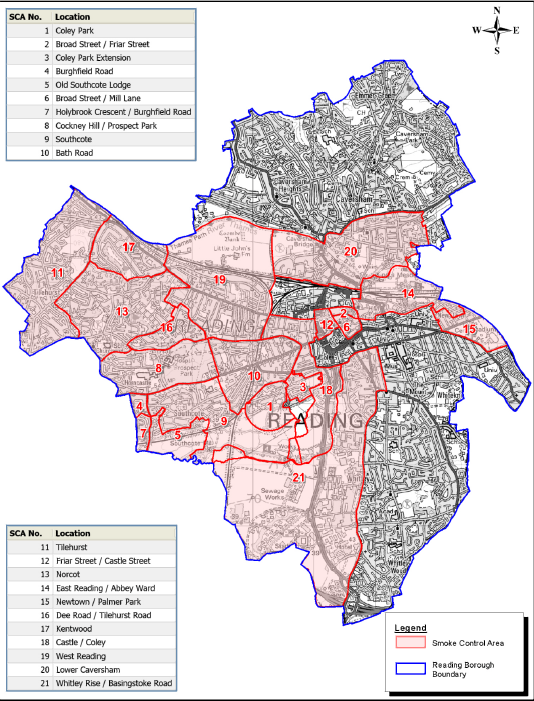Smoke Control Areas
Under the Clean Air Act Local Authorities can designate smoke control areas (SCAs).
Within these areas it is an offence to emit a substantial amount of smoke from a chimney of a building, from a furnace or from any fixed boiler. It is also an offence to acquire “unauthorised fuel” for use within a smoke control area unless it is used in an “exempt” appliance (“exempted” from the controls which generally apply in the smoke control area).
The current penalty for emitting smoke from a chimney is between £175 and £300, imposed by service of a Fixed Penalty Notice. The penalty for an unauthorised fuel offence is up to £1,000 for each offence, upon conviction.
Smoke Control Areas in Reading
Reading currently has 21 active SCAs. An interactive map is available on the Defra website which allows you to search for specific addresses to see if you are within a smoke control area. You can also access a list of Reading streets that are currently covered by SCAs.
Reading Borough Council ran a public consultation on introducing a boroughwide SCA between 4 September and 16 October 2023. Following the consultation process and subsequent government approval a boroughwide SCA will be introduced in Reading from 1 December 2024.
A draft smoke control area document is available to view.
Map of Smoke Control Areas in Reading

What you can burn if you live inside a SCA
Inside a SCA, you can still use outdoor barbecues, chimineas, garden fireplaces or pizza ovens, as long as these appliances do not release smoke through a chimney of a building – for example a summerhouse, otherwise they will only be able to burn authorised fuel or must be exempt.
You are allowed garden bonfires in SCAs, as long as you follow the rules on bonfires described on our Bonfires Page.
Amendments to SCA enforcement under the Environment Act 2021
- Financial penalties to those who emit substantial amounts of smoke from their chimney inside a SCA can be issued. The financial penalties range from a minimum of £175 to a maximum of £300
- Abatement notices can be issued for smoke emissions that are harmful to human health or a nuisance in a SCA
More detailed information about the complete changes to SCA legislation can be found on the DEFRA website.
The current maximum level of fine for burning unauthorised fuel or using a non-exempt appliance within a SCA is of £1,000 for each offence, upon conviction.
Legislation that applies to those who live outside a SCA
If you live outside a SCA, you are covered by the Environmental Protection Act (EPA) 1990. Under this act, any smoke emitted from a domestic chimney can be deemed a statutory nuisance if it is prejudicial to health or causing a nuisance.
For the smoke to count as a statutory nuisance it must do one of the following:
- unreasonably and substantially interfere with the use or enjoyment of a home or other premises
- injure health or be likely to injure health.
Report a problem
If you think there is an infringement of SCA legislation in our local area, you can report the problem to us using our online form.
Report a pollution problem
Advice on SCA authorised appliances and fuel, and how to burn fuel efficiently
- DEFRA Guidance: Open fires and wood-burning stoves
- Information leaflet from Burn right: How to get the best from your fire or stove
- Hetas: Advice leaflets for stoves and fuel
- DEFRA guidance: List of approved wood burning appliances for use in SCAs
- Guidance from DEFRA: List of authorised fuels for use in SCAs
Good practice
- Consider burning less – Think about why you are lighting your fire as well as how much fuel you use. Is it necessary?
- Buy ‘Ready to Burn’ fuel – If you want to burn look for the logo as a guarantee of good quality dry wood.
- Season freshly chopped wood before burning. Wet or unseasoned wood, often sold in nets, is cheaper to buy, but it needs to be seasoned (dried) to less than 20% water before burning. Wet wood contains moisture which impairs efficient burning, creating smoke and the release of harmful particulates when burned. This can damage your stove and chimney. It also means you’re losing out on heat for your home.
- Do not burn treated waste wood (e.g. old furniture, pallets or fence panels) or household rubbish. Treated waste wood, furniture and household waste can emit harmful fumes and toxic pollutants, such are carbon monoxide, arsenic, hydrogen chloride and cyanide, into your home when burnt.
- Regularly maintain and service your stove. This means it will work better and will generate more heat from what you burn. Always operate your stove in line with the manufacturer’s guidance and only burn permitted fuels.
- Get your chimney swept regularly (up to twice a year) – During use soot and tar build up in the chimney reducing the efficiency and increasing the risk of chimney fires. It is better to use a qualified chimney sweep who will be able to advise you on good burning practices for your open fire or stove.